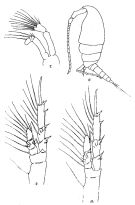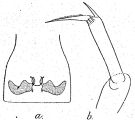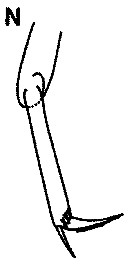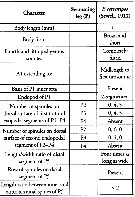|
|
 |
|
Calanoida ( Order ) |
|
|
|
Calanoidea ( Superfamily ) |
|
|
|
Paracalanidae ( Family ) |
|
|
|
Parvocalanus ( Genus ) |
|
|
| |
Parvocalanus serratipes (Sewell, 1912) (F,M) | |
| | | | | | | Syn.: | Paracalanus serratipes Sewell, 1912 (p.332, figs.F,M); 1914 a (p.208); 1929 (p.66, figs.F); 1948 (p.323, 429); Rose, 1956 (p.460); Silas, 1972 (p.645) | | | | Ref.: | | | Bradford, 1978 (p.133); Hiromi, 1987 (p.153); Kesarkar & Anil, 2010 (Rem.: p.405); S.Y. Moon & al., 2014 (p.45: F) |  Issued from : R.B.S. Sewell in Rec. Indian Mus., 1912, 7. [Pl.XV, figs.6-10]. As Paracalanus serratipes. Male (from Bay of Bengal): 6, habitus (lateral left side); 7, A2; 8, P1. Nota: Abdomen length co,tained 2.5 times in that of the cephalothorax. Proportional lengths of urosomites and caudal rami as 10:20:16:16:12:10. Rostrum consists of 2 short stout spines. A1 20-segmented (segments 1-2, 3-6, 7-8, fused).Endopodite of A2 terminates in a nipple-like projection. Left P5 considerably the larger, 4-segmented in addition to the enlarged basal portion.; the proportional lengths of these segments are 15:18:16:12; the penultimate segment bears a distal spinous process and the last segment terminates in 2 processes of unequal length; the right P5 3-segmented and terminates in 2 short processes. Female: 9, P2; 10, P3. Nota: Proportional lengths of urosomites and caudal rami as 22:12:11:18:10. A1 23-segmented (segments 1-2 and 8-9 fused) reaching the middle of abdomen, segments 2 to 9 bear a transverse row of fine spines on their posterior surfaces close to the distal border, and on segments 10 to 24 there are longitudinal rows of spines (as in P. aculeatus. 1 st basal segment bears a few spines on its anterior surface1 st exopodal segment bears a small transverse row of spines on its distal external margin. P5 is the same as in P. dubia, but in a few specimens a third small segment was intercalated between the usual two.
|
 Issued from : R.B.S. Sewell in Mem. Indian Mus., 1929, X. [p.66, fig.22]. As Paracalanus serratipes. Female (from N Indian Ocean): a, genital segment (ventral); b, P5.
|
 issued from : K.S. Kesarkar & A.C. Anil in J. mar. Biol. Ass. UK, 2010, 90 (2); [p.405, Table 2]. Characteristics of females. (X: figure not available).
|
 issued from : K.S. Kesarkar & A.C. Anil in J. mar. Biol. Ass. UK, 2010, 90 (2); [p.407, Fig.5, N]. Female:N, P5.
|
 Issued from : S. Y. Moon, S.-H. Youn & H.Y. Soh in ZooKeys, 2014, 456. [p.42, Table I]. Female : marphological characters. Compare with other species of Parvocalanus : ( arabiensis, crassirostris, dubia, elegans, latus, leei, scotti).
| | | | | Compl. Ref.: | | | Madhupratap & Haridas, 1986 (p.105, tab.1) | | | | NZ: | 2 | | |
|
Distribution map of Parvocalanus serratipes by geographical zones
|
| | | | | | | | | | Loc: | | | N Indian (Sri Lanka: Pearl Banks, Nicobar Is., Chittagong, Burma, Rangoon et Tavoy River Estuary), Viet-Nam (Cauda Bay) | | | | N: | 4 | | | | Lg.: | | | (81) F: 1,1; M: 1,1; {F: 1,10; M: 1,10} | | | | Rem.: | coastal and in estuaries.
According to Sewell (1912, p.332) several specimens of this species were associated with P. dubia off Chittagong. | | | Last update : 07/04/2018 | |
|
|
 Any use of this site for a publication will be mentioned with the following reference : Any use of this site for a publication will be mentioned with the following reference :
Razouls C., Desreumaux N., Kouwenberg J. and de Bovée F., 2005-2025. - Biodiversity of Marine Planktonic Copepods (morphology, geographical distribution and biological data). Sorbonne University, CNRS. Available at http://copepodes.obs-banyuls.fr/en [Accessed December 04, 2025] © copyright 2005-2025 Sorbonne University, CNRS
|
|
 |
 |







